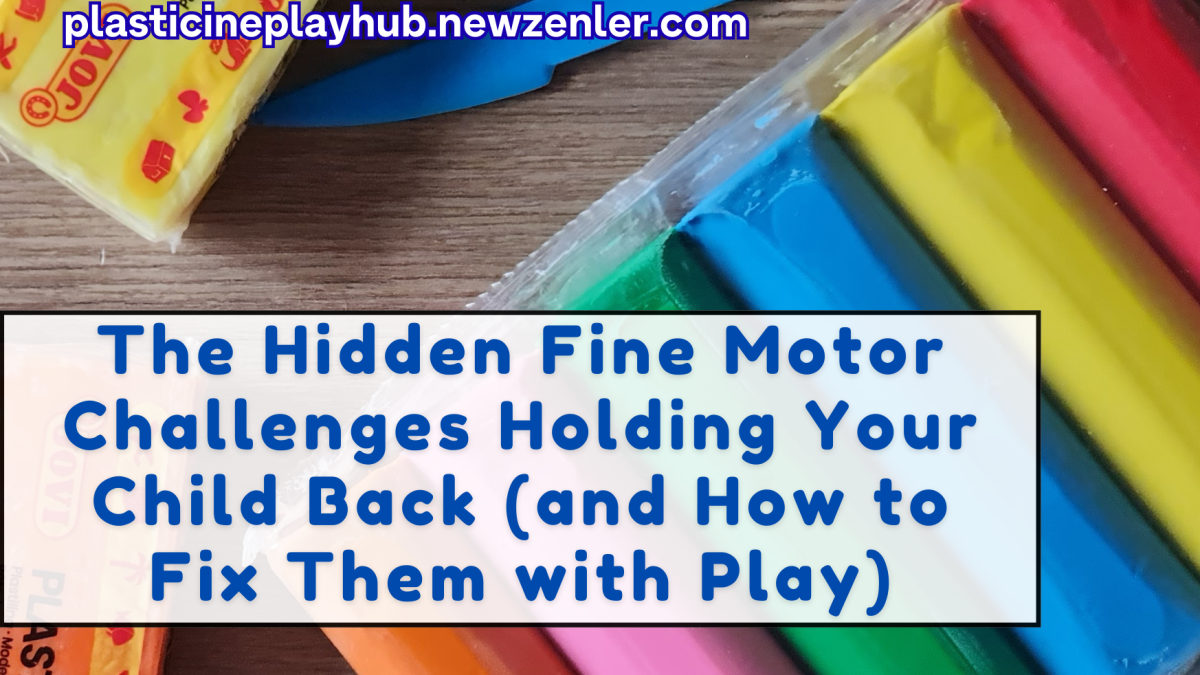The Hidden Fine Motor Challenges Holding Your Child Back (and How to Fix Them with Play)

Discover hidden fine motor challenges that may be holding your child back and learn how simple play with plasticine can build hand strength and school
You watch your child sitting at the table, pencil in hand, trying to copy a simple line. Their shoulders tense, their little fingers wrap awkwardly around the pencil, and their tongue sticks out in concentration. A few seconds later, they sigh and give up.
It’s not that your child isn’t smart. It’s that their hands and fingers simply aren’t ready yet.
And here’s the truth most parents aren’t told:
If the fine motor skills — the tiny, precise movements of the hands and fingers — aren’t strong, school tasks like writing, cutting, or even tying shoelaces become frustrating battles.
The Quiet Problem Hiding in Plain Sight
Fine motor delays aren’t always obvious. Your child might be able to build a LEGO tower, turn the pages of a book, or even color for a short while — but the moment they need control, endurance, and precision, things fall apart.
Some common signs include:
- Pencil grip that looks awkward or changes often
- Avoidance of drawing, coloring, or writing
- Struggling to cut along lines or manage scissors
- Fatigue after short fine-motor tasks
- Messy or oversized handwriting for their age
These little struggles might seem harmless now, but as your child moves into early school years, the demand for writing readiness increases rapidly.
Without intervention, they may begin to associate learning tasks with failure — and that’s when confidence starts to crumble.
Why Worksheets and Pencil Practice Often Fail
Many parents try to help by giving more worksheets or encouraging extra handwriting practice. Unfortunately, if your child’s hands aren’t strong enough yet, this approach often backfires.
Think of it like asking someone to run a marathon without first building their leg muscles — it’s not just unhelpful, it’s exhausting and demotivating.
Fine motor skill development is like training a muscle. Kids need activities that:
- Strengthen small hand and finger muscles
- Improve hand–eye coordination
- Increase grip endurance
- Develop bilateral coordination (both hands working together)
And here’s where plasticine play becomes a game-changer.
Why Plasticine Play Works When Other Methods Don’t
Plasticine — that soft, moldable material kids can’t resist squishing — is a perfect, low-pressure way to train fine motor muscles without the fight.
Here’s why it works so well:
- Resistance builds strength: Molding, rolling, and pinching plasticine activates small hand muscles in a way pencils can’t.
- Play keeps attention longer: Kids stay engaged far longer with something they can squish and create.
- It’s adaptable: You can target specific skills without your child even realizing it’s “practice.”
- Zero pressure: No red marks, no erasing, no “wrong answers.”
In my Plasticine Play Hub programs — like our Plasticine Play Weather Series — kids learn pre-writing shapes, lines, and patterns by tracing them with plasticine instead of pencils. It’s the same skill pathway, but without the stress.
Real-Life Example: From Avoiding Pencils to Drawing with Confidence
Take “Sam,” a 6-year-old who avoided all writing tasks. At school, he’d lose focus within minutes. At home, worksheets led to tears.
Instead of pushing more pencil work, his mom introduced 10 minutes of plasticine play after school:
- Rolling “snakes” to form shapes on a worksheet
- Pinching small bits to create weather icons (raindrops, clouds, sun rays)
- Flattening and shaping to match patterns on a page
Within weeks, his grip strength improved — and when he finally picked up a pencil again, he could control it without fatigue.
No battles. No worksheets. Just hands-on play that worked with his natural interests.
Try This: 5-Minute Fine Motor Boost
You can start today with this quick routine:
- Give your child a ball of plasticine (about the size of a golf ball).
- Ask them to roll it into the longest “snake” they can without breaking it.
- Shape that snake into a circle, triangle, or square on the table.
- Challenge them to pinch tiny “raindrops” to fill the shape.
It’s fun, fast, and builds hand strength, grip control, and focus — the building blocks for handwriting readiness.
Why Fixing Fine Motor Skills Early Matters
Strong fine motor skills open doors to:
- Confident handwriting
- Independence in daily tasks (buttoning, zipping, tying shoes)
- Better focus and patience
- Improved academic performance
But perhaps most importantly, early success builds self-esteem. When kids feel capable, they’re more willing to try — and keep trying.
Ready to Help Your Child?
If you’re tired of battles over pencils and worksheets, you’ll love the Plasticine Play Weather Series.
It’s a step-by-step, parent-friendly system for building fine motor strength, focus, and writing readiness — all through play.
With purposeful plasticine play and printable worksheets designed for little hands, your child can:
- Strengthen hand muscles without pressure
- Learn pre-writing patterns naturally
- Build the focus needed for school tasks
Next up: Discover The Surprising Link Between Plasticine Play and Better Focus in Kids — and how a few minutes of hands-on fun can unlock your child’s concentration skills in ways screens never could.
Categories: : fine motor development
 Tamara Mamedova
Tamara Mamedova 